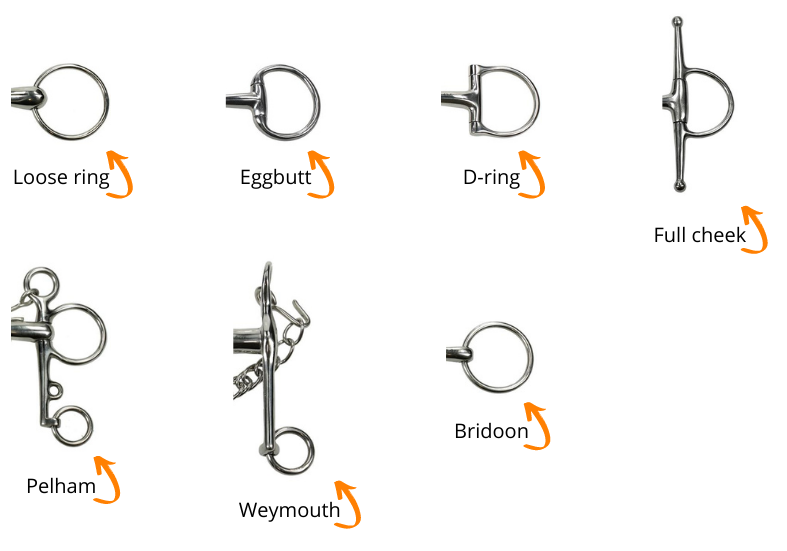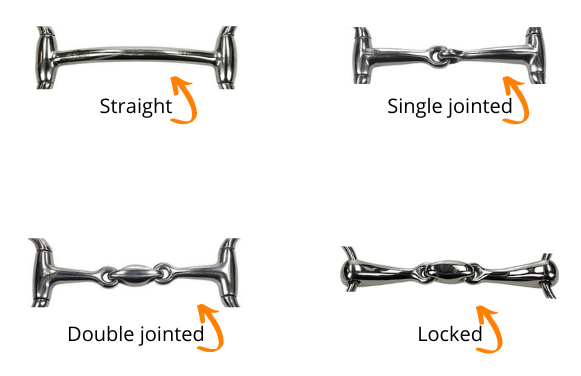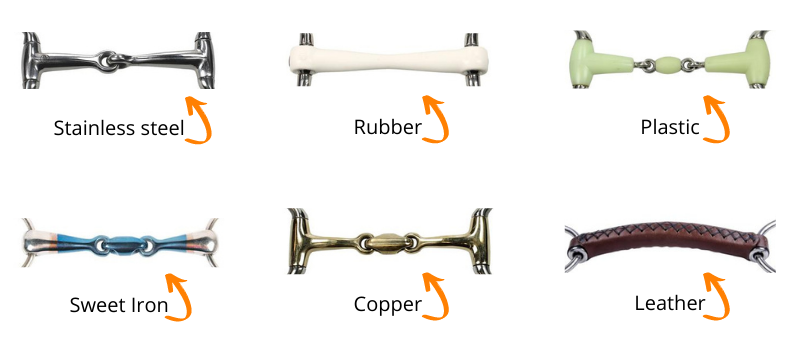Every horse and rider have different needs. For every purpose there is a different kind of bit available at Epplejeck. Have you spent hours scouring the internet looking for the right bit for your horse? Don’t worry, after reading this blog you won’t struggle a single bit to find the perfect match!
Cheekpieces

The part of the bit that is visible on the outside and rests against the cheeks of the horse is the cheekpiece. There are many different types.
• The
loose ring has, as the name suggests, loose rings that can rotate through the mouthpiece. This allows the bit to move more freely. It lies relatively loose in the horse’s mouth, therefore the rein aid has a more indirect effect. To prevent the lips and skin in the corners of the mouth from getting pinched, it is advised to provide the bit with bit rings.
• The
eggbutt has solid rings. Therefore it lies more stable in the mouth and has a stronger effect. The rein aid is more directly.
• The
D-ring ensures that the mouthpiece lies more stable and quiet in the horse’s mouth. The pressure of the D-shaped rings makes turning easier, as the horse’s head is automatically steered in the right direction. This makes the bit especially suitable for young horses, as they usually don’t understand the pressure in their mouths yet.
• Just like the D-ring, the
full cheek is very suitable for young horses because of the straight cheekpieces and solid rings. Therefore, the bit can’t be pulled through the mouth so easily. The straight cheekpieces ensure a stable position of the bit and exert pressure on the cheeks of the horse, which makes it easier to turn.
• A
pelham combines the effect of a regular bit and a Weymouth bridle. It can be used with one or two reins. In case you want to use it with one rein, a pelham strap is needed to connect both rings to the reins. Because of the lever action, this bit is sharper than most bits. The longer the shanks, the sharper the effect. A pelham bit is mainly used with very strong horses, horses which have to get used to the Weymouth bridle, or which have too little space in the mouth for two mouthpieces.
• A
Weymouth is used in combination with a bridoon for the so-called double bridle. The Weymouth consists of a straight mouthpiece, two shanks that can vary in length and shape, and a curb chain. The curb chain prevents the bit from turning too much in the horse’s mouth. The Weymouth bit is only used in the higher dressage classes. To use the Weymouth bit, a special double bridle is required.
• A
bridoon is used in combination with a Weymouth bit for a double bridle. A bridoon is similar to a regular bit. The difference is is that a bridoon is thinner and has smaller rings on the cheekpiece. The small rings have a more direct effect compared to bigger rings, as there is more pressure transferred to a smaller area. The smaller rings provide enough space for the Weymouth bit. To use the bridoon bit, a special double bridle is required.
Mouthpieces

The mouthpiece determines the effect of the bit. It can exert pressure on the tongue, layers, palate and corners of the mouth.
• The
straight mouthpiece consists of one piece, which is usually slightly curved. It transfers the pressure evenly, mainly on the tongue and lips, less on the layers. It has no effect on the palate.
• A
single jointed bit has a mouthpiece that consists of two equally long parts connected by one hinge. Because of this hinge point, the pressure is exerted differently across the layers, tongue and palate. When used incorrectly, the mouthpiece can pinch the palate and corners of the mouth like a nutcracker.
• A
double jointed bit consists of two equally long parts, and in the middle a small piece that has two hinges. Because of this, one-sided pressure is possible. The bit is shaped more towards the mouth and lies slightly looser in the mouth. The pressure is exerted on the tongue, layers and corners of the mouth.
• The
locked mouthpiece looks like the single jointed one. The difference is that the bit blocks when pressure is applied to the reins. This turns it into a straight mouthpiece. With less pressure on the reins, the bit changes back into a jointed bit. A locked bit is perfect for horses that tend to resist and ignore the bit.
Materials

As if there wasn’t enough choice yet, there are also many different materials to choose from! Based on your horse's behaviour, you can choose the most suitable material.
•
Stainless steel is the most commonly used material for bits, as it is strong and easy to clean. Although for the horse it feels cold and doesn’t stimulate the saliva production.
•
Rubber makes metal bits less sharp, but it’s not durable and easily chewed to pieces. Another downside is that a rubber bit can get too hot from friction.
•
Plastic is used around metal bits. Some plastic mouthpieces contain a fruit flavour to make the bit more attractive and enjoyable for the horse.
•
Sweet Iron bits are made of steel. The mouthpiece has a striking blue colour and will rust when it comes into contact with humidity. This gives a sweet taste and naturally stimulates the production of saliva. The increase of saliva will encourage a better acceptance of the bit. Because of the rusting, the blue colour changes to brown/silver, which is the desired effect.
•
Copper bits are similar to Sweet Iron. They warm up faster to the horse’s body temperature than stainless steel bits, but do not last as long. The copper ensures a sweet taste and stimulates the horse’s saliva production.
• The production of saliva makes a
leather bit soft and pleasant for the horse. Horses with a sensitive mouth will enjoy the flexible material in combination with the taste of leather.
Hopefully we have made it a little easier for you to make a decision from our wide range of bits. Of course, if you are in doubt which one to get, you can always ask your trainer for advice or contact our
customer service.
Check out our full collection of bits
here!